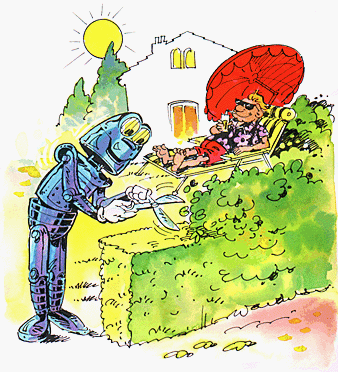
A click on the image will take you to the series of illustrated quizzes which will appear in random order or you may click on this image quiz link.
An example of an android or a male robot. Yes, there are gender differences among the robots. They definitely should not all be labeled as androids.
2. An automaton resembling a man; manlike.
3. In science fiction, a robot that looks and behaves like a human being; especially, a man.

This is an example of an android who is working for an andric human. For the female equivalent, see gynoid.
The origin of the word robot
In 1920, a Czech playwright, Karel Capek, wrote R.U.R., a play in which automata are mass-produced by an Englishman named Rossum. The automata are meant to do the world’s work and to make a better life for human beings, but in the end they rebeled, wiped out humanity, and started a new race of intelligent life.
Rossum comes from a Czech word, rozum, meaning "reason"; and R.U.R. stands for "Rossum’s Universal Robots", where robot is a Czech word for "worker", with the implication of involuntary servitude, so that it might be translated as "serf" or "slave".
The popularity of the play threw the old term "automaton" out of use. The new term, "robot" has replaced it in every language, so that now a robot is commonly thought of as any artificial device (often pictured in at least vaguely human form) that will perform functions ordinarily thought to be appropriate for human beings.
Despite what many people think, all robots are not androids! They may be observed as androids if they have the appearance of being masculine; however, if they show feminine characteristics, then they should be considered gynoids; as shown at this link. Of course, if a robot does not show masculine nor feminine features, then it probably should be called by its neuterized term of robot (neither feminine nor masculine). We can also create a new word: neuteroid. So, we now have three gender-characterized robots: androids, gynoids, and neuteroids.
After coming up with the neuteroid idea, a Google search was made to see if the word existed; and, what do you know, there was ONE and only one neuteroid reference which happened to be a science-fiction story created by an anonymous writer at the University of Missouri Rolla, "Missouri's Premier Technological Research University".
A current attempt to see the story via a link resulted in finding out that it no longer exists!
The writer made the same distinctions between android, gynoid, and neuteroid; just as it has been presented in this section.
The inlet is wedge-shaped, the side walls converge, and the retropubic angle and the subpubic arch are both narrow.
